DISCURSOS - Rotary International
DISCURSOS - Rotary International
DISCURSOS - Rotary International
Create successful ePaper yourself
Turn your PDF publications into a flip-book with our unique Google optimized e-Paper software.
Rotarians will go out of their way to make you feel welcome and comfortable. What a family we<br />
belong to! We can call almost anywhere in the world home.<br />
Let us remember that in reaching our goal of service, none of us can effectively do so alone;<br />
there are others who are just as committed and passionate as we are. We must help and rely on<br />
one another. This is the sense in which <strong>Rotary</strong> is like a family. This extended family includes not<br />
only Rotarians but their spouses and other family members and former Rotarians who provide<br />
critical support to <strong>Rotary</strong>’s service efforts.<br />
Our partners in service — Rotaract, Interact, and <strong>Rotary</strong> Community Corps — are also part of this<br />
wide <strong>Rotary</strong> family dedicated to improving life in their communities and throughout the world.<br />
Like most families, the <strong>Rotary</strong> family provides a haven where we can gather the strength and encouragement<br />
to face the challenges of the world. The poet and writer Goethe said, “Treat people<br />
as if they were what they ought to be and you will help them to become what they are capable<br />
of being.” A club can always create supportive beneficial synergy with these extended family<br />
members.<br />
And there are others, too, who can come under our umbrella of service. Each year, thousands<br />
of young men and women participate in <strong>Rotary</strong>’s educational and New Generations programs,<br />
which enable them to develop new skills, serve their communities, and foster international understanding.<br />
Very often, we do not employ the experience gained by these young people to its<br />
full potential. The experience does not have to end when the program is over. As alumni, they<br />
are part of an extended network of people who share a common bond. They will always belong<br />
to the family of <strong>Rotary</strong>, and it behooves us to keep them involved with the idea and resources of<br />
Rotarians and alumni. They should stay connected with <strong>Rotary</strong>, and the transition to becoming<br />
Rotarians should be an easy walk-through for these natural prospects.<br />
During my visit to Brazil, a young Zimbabwean on a Youth Exchange program was our interpreter,<br />
using her recently acquired skills of translating Portuguese into English. My wife kept in contact<br />
with her, and we met again in London and were excited to learn of her interest in becoming a<br />
Rotarian. <strong>Rotary</strong> brought us together; <strong>Rotary</strong> is teaching her to serve.<br />
And as we cast our net to find synergies with like-minded people, it is desirable that we cultivate<br />
new relationships with individuals and organizations such as Rotarian Action Groups and networking<br />
groups that share <strong>Rotary</strong>’s goals. In very significant ways, they complement the delivery<br />
efforts of <strong>Rotary</strong> service and are important fibers in the fabric of the <strong>Rotary</strong> tapestry.<br />
Under the Future Vision Plan of the <strong>Rotary</strong> Foundation, new strategic partnerships are being<br />
developed. A strategic partnership is a relationship between The <strong>Rotary</strong> Foundation and another<br />
international organization that has a unique or specialized knowledge or expertise in one or more<br />
of the areas of focus. These relationships, too, will produce mutually beneficial project portfolios<br />
that fulfill the goals of the partners and enhance service opportunities for Rotarians. In time,<br />
these partners, too, may become members of the family of <strong>Rotary</strong>.<br />
It is clear, then, that the concept of the family of <strong>Rotary</strong>, if properly harnessed, can be an effective<br />
tool for improving our membership drive. Everybody knows the now-familiar refrain of the need<br />
to bring younger people into <strong>Rotary</strong>. Throughout the <strong>Rotary</strong> world, our younger members tell us<br />
that they don’t like to feel that <strong>Rotary</strong> time competes with family time. If we support opportunities<br />
to include families in fellowship and service events, then there is no conflict, as the family<br />
member who is involved in <strong>Rotary</strong> will better understand why the club member makes time for<br />
<strong>Rotary</strong>.<br />
In such an atmosphere of family and caring, the death of a Rotarian should not be the end of<br />
<strong>Rotary</strong>’s relationship with his or her family — certainly there are ample opportunities to include a<br />
deceased Rotarian’s family in <strong>Rotary</strong>-sponsored events. The late President Glenn Estess, discussing<br />
the subject of the family of <strong>Rotary</strong> in 2005, stated:<br />
<strong>International</strong> Assembly Speeches 2013 21


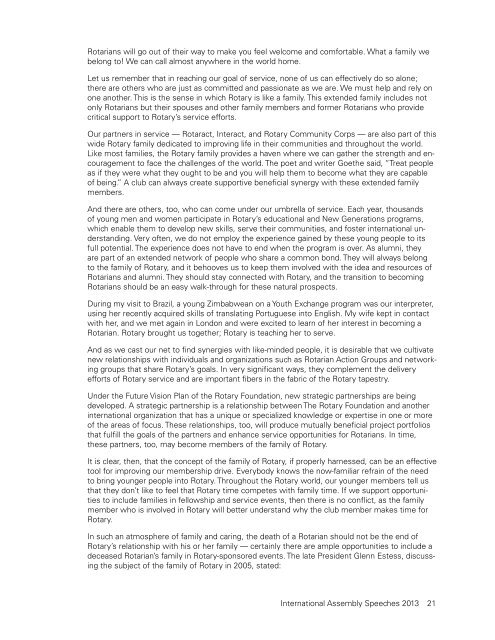
![La présidence du club [222-FR] - Rotary International](https://img.yumpu.com/25855726/1/190x245/la-presidence-du-club-222-fr-rotary-international.jpg?quality=85)

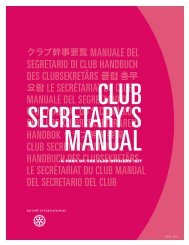

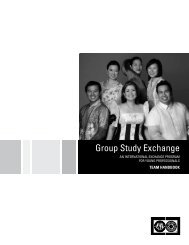
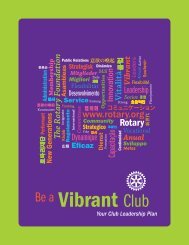
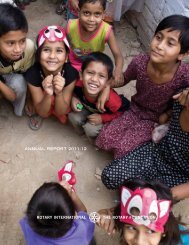
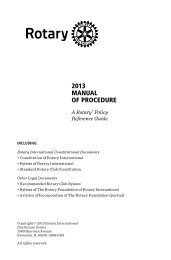

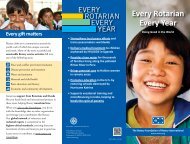
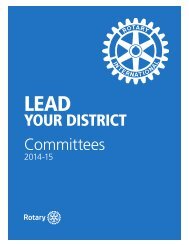

![La conférence de district [800-FR] - Rotary International](https://img.yumpu.com/25855636/1/190x245/la-conference-de-district-800-fr-rotary-international.jpg?quality=85)
